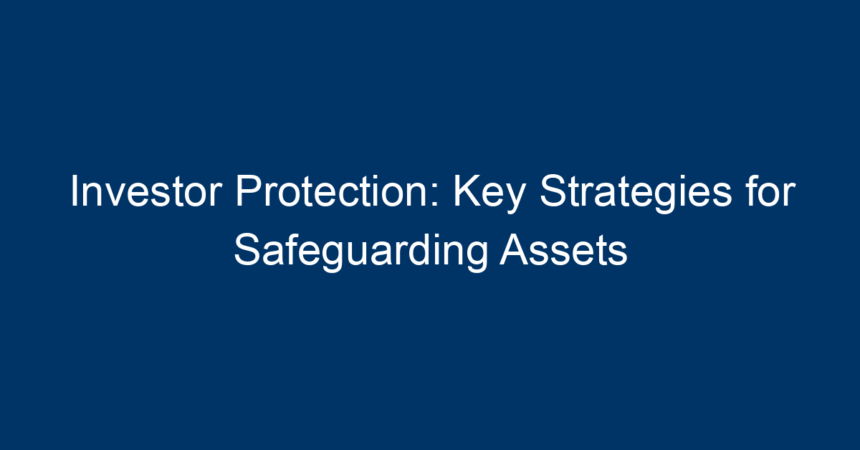In a world where financial markets are constantly changing and investment opportunities abound, the importance of investor protection cannot be overstated. With the rise of digital trading platforms, volatile markets, and increasing complexity in financial products, safeguarding your investments has become more critical than ever. This article dives into key strategies that every investor should consider to protect their assets effectively.
Understanding Investor Protection
Before we explore strategies for safeguarding assets, it’s essential to understand what investor protection entails. At its core, investor protection refers to the measures taken to secure the rights and interests of investors in financial markets. This can be through regulatory policies, investment education, and personal strategies designed to minimize risks.
The objective is to provide a safety net that allows investors to partake in financial markets without undue fear of loss. Governments and regulatory bodies play a vital role in fostering an environment where investors can confidently engage in various investment opportunities.
The Importance of Diversification
What Is Diversification?
Diversification is a risk management strategy that involves spreading investments across various financial instruments, industries, and other categories. The idea is that a diverse portfolio can help mitigate losses; if one investment performs poorly, others may perform well, balancing the overall risk.
How to Diversify Your Portfolio
-
Asset Classes: Consider diversifying across different types of assets, such as stocks, bonds, real estate, and commodities.
-
Sectors and Industries: Invest in different sectors like technology, healthcare, and consumer goods to spread risk within the stock market.
-
Geographical Diversification: Broaden your investment horizon by including international assets, which can potentially reduce risks associated with domestic economic fluctuations.
- Invest in Mutual Funds and ETFs: These funds inherently offer diversification, as they pool together various assets and distribute risk among their investors.
Why Diversification Matters
By implementing a robust diversification strategy, you lower the chances of significant losses during market downturns. Studies indicate that diversified portfolios tend to outperform non-diversified ones over the long term, making diversification a fundamental pillar of investor protection.
Understanding Financial Statements
The Role of Financial Literacy
An essential aspect of investor protection lies in understanding financial statements. Knowledgeable investors can better assess the performance and stability of their investments, helping them make informed decisions.
Key Financial Statements to Know
-
Balance Sheet: Provides a snapshot of a company’s assets, liabilities, and equity at a specific point in time.
-
Income Statement: Shows the company’s revenues, expenses, and profits over a period, offering insights into its operational efficiency.
- Cash Flow Statement: Highlights the inflow and outflow of cash, crucial for understanding the liquidity and long-term viability of an investment.
Improving Your Financial Literacy
Enrich your knowledge through various resources like online courses, finance blogs, and courses at local community colleges. The more you know, the better positioned you are to protect your investments effectively.
Conducting Thorough Research
The Importance of Due Diligence
Before making any investment, conduct thorough research to ensure that you understand what you are buying. Due diligence is a critical component of investor protection. It involves evaluating an investment’s potential risks and returns by reviewing relevant information.
Steps to Conduct Comprehensive Research
-
Market Trends: Keep an eye on market trends related to your investment area. This means staying updated on current events and economic indicators.
-
Company Background: Investigate the company’s history, management, and competitive positioning in its industry. Look for any legal issues or controversies.
-
Analyst Reports: Use expert analysis to validate your research. Analyst reports can provide insights and forecasts that you might not consider independently.
- Peer Comparisons: Compare the target investment with its peers to understand its relative performance and risk factors.
Utilize Investment Strategies
Active vs. Passive Investing
Understanding various investment strategies can significantly enhance investor protection. While active investing involves frequent buying and selling to beat the market, passive investing aims to mirror market performance through investments like index funds.
Pros and Cons of Each Strategy
-
Active Investing:
- Pros: Potential for higher returns.
- Cons: Higher risks and fees, requiring constant monitoring.
- Passive Investing:
- Pros: Lower costs and a more hands-off approach.
- Cons: Limited opportunities for significant outperformance.
Dollar-Cost Averaging
One effective investing strategy for protection against market volatility is dollar-cost averaging. This involves regularly investing a fixed amount, regardless of market conditions. This method reduces the impact of market fluctuations on your overall investment, allowing you to purchase more shares when prices are low and fewer when prices are high.
Stay Informed About Regulatory Changes
Government and Regulatory Agencies
Keeping informed about changes in regulations ensures that you are aware of your rights as an investor. Regulatory bodies like the Securities and Exchange Commission (SEC) in the U.S. work to protect investors and maintain fair markets.
Resources for Staying Informed
-
Newsletters and Blogs: Subscribe to financial newsletters that cover regulatory updates.
-
Official Websites: Regularly check the website of your country’s financial regulatory authority for news on rules and regulations.
- Investor Forums: Engage in online communities where you can learn from other investors’ experiences and insights.
Effective Use of Technology
Technological Solutions for Investor Protection
In the digital age, technology can serve as a powerful ally in investor protection. From investment apps to AI-powered analysis tools, technology can help streamline your investment strategy.
-
Investment Management Software: These tools allow you to track your portfolio performance and automatically rebalance it when necessary.
-
Risk Assessment Tools: Online platforms can help you understand the risks associated with your investment choices.
- Alerts and Notifications: Set up alerts for significant price changes or news related to your investments.
Conclusion: Actionable Insights for Investors
In summary, protecting your investments requires a multi-faceted approach. The cornerstone of investor protection includes diversification, financial literacy, thorough research, strategic investing, staying informed about regulations, and leveraging technology. By implementing these strategies, you not only enhance your chances of achieving financial success but also build a resilient portfolio capable of weathering market storms.
As you embark on your investment journey, remember that knowledge is power. Continuously educate yourself and adapt to changing market conditions. In doing so, you will be better positioned to make informed investment decisions and safeguard your assets effectively.
Take Action Today
Start by assessing your current portfolio for diversification opportunities. Brush up on your financial literacy, and don’t hesitate to seek professional advice when needed. The financial market is vast, but with the right strategies, you can navigate it confidently and securely.




